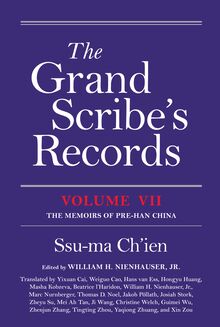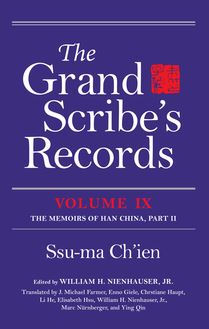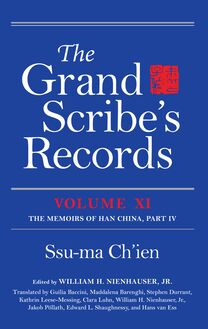-
 Univers
Univers
-
 Ebooks
Ebooks
-
 Livres audio
Livres audio
-
 Presse
Presse
-
 Podcasts
Podcasts
-
 BD
BD
-
 Documents
Documents
-
- Cours
- Révisions
- Ressources pédagogiques
- Sciences de l’éducation
- Manuels scolaires
- Langues
- Travaux de classe
- Annales de BEP
- Etudes supérieures
- Maternelle et primaire
- Fiches de lecture
- Orientation scolaire
- Méthodologie
- Corrigés de devoir
- Annales d’examens et concours
- Annales du bac
- Annales du brevet
- Rapports de stage
La lecture à portée de main
Vous pourrez modifier la taille du texte de cet ouvrage
Découvre YouScribe en t'inscrivant gratuitement
Je m'inscrisThe Grand Scribe's Records, Volume XI , livre ebook
Découvre YouScribe en t'inscrivant gratuitement
Je m'inscrisEn savoir plus
Vous pourrez modifier la taille du texte de cet ouvrage
En savoir plus

Description
The Grand Scribe's Records, Volume XI presents the final nine memoirs of Ssu-ma Ch'ien's history, continuing the series of collective biographies with seven more prosopographies on the ruthless officials, the wandering gallants, the artful favorites, those who discern auspicious days, turtle and stalk diviners, and those whose goods increase, punctuated by the final account of Emperor Wu's wars against neighboring peoples and concluded with Ssu-ma Ch'ien's postface containing a history of his family and himself.
Sujets
Informations
| Publié par | Indiana University Press |
| Date de parution | 31 juillet 2019 |
| Nombre de lectures | 0 |
| EAN13 | 9780253048462 |
| Langue | English |
| Poids de l'ouvrage | 8 Mo |
Informations légales : prix de location à la page 0,0150€. Cette information est donnée uniquement à titre indicatif conformément à la législation en vigueur.
Extrait
The Grand Scribe s Records
VOLUME XI
The Memoirs of Han China IV
The Grand Scribe s Records
VOLUME XI
The Memoirs of Han China IV
by Ssu-ma Ch ien
William H. Nienhauser, Jr. Editor
Giulia Baccini, Maddalena Barenghi, Stephen Durrant, Kathrin Leese-Messing, Clara Luhn, William H. Nienhauser, Jr., Jakob P llath, Edward L. Shaughnessy, and Hans van Ess, Translators
INDIANA UNIVERSITY PRESS NANJING UNIVERSITY PRESS
This book is a copublication of
Indiana University Press
Office of Scholarly Publishing
Herman B Wells Library 350
1320 East 10th Street
Bloomington, Indiana 47405 USA
iupress.indiana.edu
and
Nanjing University Press
22 Hankou Road
Nanjing, Jiangsu, China
1994 by William H. Nienhauser, Jr.
2019 by William H. Nienhauser, Jr.
All rights reserved
No part of this book may be reproduced or utilized in any form or by any means, electronic or mechanical, including photocopying and recording, or by any information storage and retrieval system, without permission in writing from the publisher. The paper used in this publication meets the minimum requirements of the American National Standard for Information Sciences-Permanence of Paper for Printed Library Materials, ANSI Z39.48-1992.
Manufactured in the United States of America
Originally cataloged by the Library of Congress as
Ssu-ma Ch ien, ca. 145-ca. 86 BC
[Shih chi. English]
The grand scribe s records / Ssu-ma Ch ien ; William H. Nienhauser, Jr., editor ; Giulia Baccini [et al.], translators.
p. cm.
Includes bibliographical references and index.
Contents: v. 1. The basic annals of pre-Han china
ISBN 0-253-34021-7
1. China-History-To 221 BC 2. China-History-Ch in dynasty, 221-207 BC. 3. China-History-Han dynasty 202 BC-220 CE I. Nienhauser, William H. II. Cheng, Tsai Fa. III. Title.
DS741.3.S6813 1994
931-dc20 094-18408
ISBN 978-0-253-04610-9
1 2 3 4 5 24 23 22 21 20 19
CONTENTS
Dedication
Acknowledgments
Introduction (Hans van Ess)
On Using This Book
Weights and Measures (Lu Zongli)
List of Abbreviations
Memoir 62 translated by Hans van Ess, Clara Luhn and the Munich Group
Memoir 63 translated by William H. Nienhauser, Jr
Memoir 64 translated by Clara Luhn
Memoir 65 translated by Kathrin Lesse-Messing
Memoir 66 translated by Guilia Baccini and Maddalena Barenghi
Memoir 67 translated by Jakob P llath
Memoir 68 translated by Edward L. Shaughnessy
Memoir 69 translated by Stephen Durrant
Memoir 70 translated by Hans van Ess
Frequently Mentioned Commentators
Appendix: Official Titles of the Han Dynasty
Selected Recent Studies of the Shih chi
Index
For John Gallman
ACKNOWLEDGMENTS
Let me first thank the Center for Advanced Studies at the Ludwig-Maximilian University in Munich which supported me for a month from December 2017-January 2018 and allowed me to work on these chapters with Hans van Ess and his Shih chi Group (see also below). My host, Hans van Ess, always seems to manage to find time from his duties as Vice-president of Ludwig-Maximilian University to attend all the meetings and offer countless suggestions which have improved every chapter. He also kindly consented to provide an Introduction for this volume.
Moreover, Van Ess s Shih chi Translation Group have translated and annotated five of the nine chapters in this volume. In addition to the translators Giulia Baccini, Maddalena Barenghi, Stephen Durrant, Kathrin Lesse-Messing, Clara Luhn, Jakob P llath, Edward L. Shaughnessy, the following colleagues were active in discussions of many of these translations: Zhongrong Bing , Rebecca Ehrenwirth, Sebastian Eicher, Vera Dorofeeva-Lichtmann, Masha Khayutina, Guje Kroh, Marc N rnberger, Andreas Siegl, and Nicolae Statu. Michael Naparstek (June 2016) and Masha Kobzeva (June 2017), both recent Ph.D. from the University of Wisconsin, joined the Munich Group for a month as my project assistants. I am particularly grateful to Stephen Durrant and Edward L. Shaughnessy who not only contributed chapters, but also joined the Munich group for a number of sessions.
A Workshop in May 2018 at Nanjing University allowed me to read the Ta Y an lieh-chuan (Memoir on Ferghana, chapter 123) intensively with a group of thirty-some graduate students and young faculty from Nanjing University, Nanjing Normal University, and several other schools. I am grateful to Dean Xu Xingwu for his invitation, to Hou Chengxiang , my trusty assistant for three years running, to Shih Wenjia and Dr. Ge Yanhong for handling various affairs so efficiently, and to the students and young faculty who took part (see the translator s note to chapter 123 below).
Nankai University also hosted a Workshop in June 2018 where we looked at some of the chapters that appear in this volume. My thanks to Dean Shen Liyan , to Associate Dean Feng Dajian , to my colleague Zhang Hongming , and to the former Vice-President of Nankai, Chen Hong , for their hospitality and their support, as well as for awarding me a Distinguished Visiting Professorship.
A fourth Workshop at the Elling O. Eide Center in Sarasota, Florida (1-4 November 2018) brought together members of my Shih chi Group and those of Hans van Ess along with three former members of my group: Weiguo Cao , Hongyu Huang , and Lu Zongli . Although we did not focus on the chapters in this volume, some of the discussions led us back to passages in these translations. My sincere thanks are due to Harold Mitchell and Dr. Ann Roddy for their invitation, support and cordiality.
In addition a great debt is due to my Shih chi Translation Group here at the University of Wisconsin-Madison which included Yixuan Cai , Shuyi Huang , Cheng Liu , Masha Kobzeva, Josiah Stork, Zheyu Su , Su Tong, Ji Wang , Christine Welch, Guimei Wu , Tingting Zhou , and Yaqiong Zhuang most of whom read some of these chapters.
Masha Kobzeva has not only attended every Shiji session over the past decade, but also done the map for the Memoir on Ferghana (chapter 123) and helped with various technical problems in production. Victor H. Mair and Christopher I. Beckwith read the Memoir on Ferghana and offered excellent suggestions. Wolfgang Behr provided me with guidance and materials on the same chapter. Lu Zongli has as usual been a source for the answers to many questions on several chapters. None of the aforementioned are responsible, however, for errors or infelicities remaining in the final edited version of the text.
This volume would never have been ready on schedule were it not for the generous support of the Research Committee in and Dean Lea Jacobs in the University of Wisconsin Graduate School who granted me a semester of research leave this spring.
Finally, I want to thank the excellent staff at Indiana University Press, especially David Miller, who has the keenest editorial eye I have encountered since beginning this project thirty years ago. Thinking back to 1989, I can recall fondly the unstinted support of John Gallman to whom this volume is dedicated.
William H. Nienhauser, Jr.
1 April 2019
INTRODUCTION
The Sequence of the Last Chapters of the Shih chi , the End of This History, and the Death of Ssu-ma Ch ien
Hans van Ess
Some Notes on Sequence and Numbers
Traditional Chinese commentators have often speculated about the reasons for the structure that Ssu-ma Ch ien gave his Shih chi . Departing from one passage in chapter 130 in which the historian relates the number of thirty hereditary houses to the eight lodges surrounding the pole-star, 1 they have concentrated on explaining the reason for the overall number of chapters contained in the five sections of the Shih chi 2 rather than considering the arrangement of the chapters within these sections. Yet, it does seem obvious that Ssu-ma Ch ien did not just calculate the bigger picture of his text but also very carefully thought about how to arrange individual chapters. The number twelve, which is the number of the chapters in the annals section, seems to have played an especially important role in his considerations. For example, although there are only 30 Hereditary Houses, one may argue that the first twelve chapters of them tell the story of states that were established through direct enfeoffment by the central Chou dynasty. The four chapters that follow deal with states that originated from usurpation of power. This is true for the three successor states of Chin as well as for the T ien house that took over power in Ch i. Interestingly, four chapters are followed by those on Confucius and Ch en She . While it is obvious that Ch en She fits the description of a rebel very well, an answer to the much-debated question of why the life of Confucius is described in the hereditary houses section may be that according to the tradition of the Kung-yang school of the Spring and Autumn Annals he provided a model of rule for someone who might succeed the Chou one day. Interestingly the Shih chi ends with a sentence that is almost verbatim the same as the last sentence of the Kung-yang commentary, namely that this book was written for a sage or superior man of later ages. This sentence clearly says that the Shih chi was not written for the emperor but that it contained important information for a successor to him. Seen in this light, there is a solution to the riddle of the placement of Confucius among the Hereditary Houses. His biography would then fit the other five chapters just mentioned very well. Ssu-ma Ch ien saw in Confucius a man whom he took as a model because he, too, had written for someone who would put an end to the disasters on earth that had been provo
-
 Univers
Univers
-
 Ebooks
Ebooks
-
 Livres audio
Livres audio
-
 Presse
Presse
-
 Podcasts
Podcasts
-
 BD
BD
-
 Documents
Documents
-
Jeunesse
-
Littérature
-
Ressources professionnelles
-
Santé et bien-être
-
Savoirs
-
Education
-
Loisirs et hobbies
-
Art, musique et cinéma
-
Actualité et débat de société
-
Jeunesse
-
Littérature
-
Ressources professionnelles
-
Santé et bien-être
-
Savoirs
-
Education
-
Loisirs et hobbies
-
Art, musique et cinéma
-
Actualité et débat de société
-
Actualités
-
Lifestyle
-
Presse jeunesse
-
Presse professionnelle
-
Pratique
-
Presse sportive
-
Presse internationale
-
Culture & Médias
-
Action et Aventures
-
Science-fiction et Fantasy
-
Société
-
Jeunesse
-
Littérature
-
Ressources professionnelles
-
Santé et bien-être
-
Savoirs
-
Education
-
Loisirs et hobbies
-
Art, musique et cinéma
-
Actualité et débat de société
- Cours
- Révisions
- Ressources pédagogiques
- Sciences de l’éducation
- Manuels scolaires
- Langues
- Travaux de classe
- Annales de BEP
- Etudes supérieures
- Maternelle et primaire
- Fiches de lecture
- Orientation scolaire
- Méthodologie
- Corrigés de devoir
- Annales d’examens et concours
- Annales du bac
- Annales du brevet
- Rapports de stage








